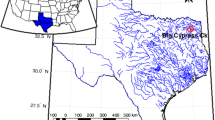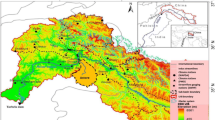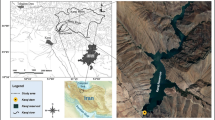Abstract
Reservoir planning and management are critical to the development of the hydrological field and necessary to Integrated Water Resources Management. The growth of forecasting models has resulted in an excellent model known as the Support Vector Machine (SVM). This model uses linearly separable patterns based on an optimal hyperplane, which are extended to non-linearly separable patterns by transforming the raw data to map into a new space. SVM can find a global optimal solution equipped with Kernel functions. These Kernel functions have high flexibility in the forecasting computation, enabling data to be mapped at a higher and infinite-dimensional space in an implicit manner. This paper presents a new solution to the expert system, using SVM to forecast the daily dam water level of the Klang gate. Four categories are identified to determine the best model: the input scenario, the type of SVM regression, the number of V-fold cross-validation and the time lag. The best input scenario employs both the rainfall R(t-i) and the dam water level L(t-i). Type 2 SVM regression is selected as the best regression type, and 5-fold cross-validation produces the most accurate results. The results are compared with those obtained using ANFIS: all the RMSE, MAE and MAPE values prove that SVM is a superior model to ANFIS. Finally, all the results are combined to determine the best time lag, resulting in R(t-2) L(t-2) for the best model with only 1.64 % error.











Similar content being viewed by others
References
Akrami SA, El-Shafie A, Jaafar O (2013) Improving rainfall forecasting efficiency using Modified Adaptive Neuro-Fuzzy Inference System (MANFIS). Water Resour Manag, pp 1573–1650
An S, Liu W, Venkatesh S (2007) Fast cross-validation algorithms for least squares support vector machine and kernel ridge regression. Pattern Recog 40(8):2154–2162
Bacanli UG, Firat M, Dikbas F (2009) Adaptive neuro-fuzzy inference system for drought forecasting. Stoch Env Res Risk A 23:1143–1154
Behzad M, Asghari K, Eazi M, Palhang M (2009) Generalization performance of support vector machines and neural network in runoff modelling. Expert Syst Appl 36:7624–7629
Dastorani MT, Moghaddamnia A, Piri J, Rico-Ramirez M (2010) Application of ANN and ANFIS models for reconstructing missing flow data. Environ Monit Assess 166:421–434
Efe MO (2009) A comparison of ANFIS, MLP and SVM in identification of chemical processes. Control Applications, (CCA) & Intelligent Control, (ISIC), 689–694
El-Shafie A, Noureldin A (2010) Generalized versus non-generalized neural network model for multi-lead inflow forecasting at Aswan High Dam. Hydrol Earth Syst Sci Discuss 7(5):7957–7993
El-Shafie A, Jaafer O, Seyed A (2011a) Adaptive neuro-fuzzy inference system based model for rainfall forecasting in Klang River, Malaysia. Int J Phys Sci 6(12):2875–2888
El-Shafie AH, El-Shafie A, El Mazoghi HG, Shehata A, Taha MR (2011b) Artificial neural network technique for rainfall forecasting applied to Alexandria, Egypt. Int J Phys Sci 6(6):1306–1316
Feng CXJ, Yu ZGS, Kingi U, Baig MP (2005) Threefold vs. fivefold cross validation in one-hidden-layer and two-hidden-layer predictive neural network modelling of machining surface roughness data. J Manuf Syst 24(2):93–107
Firat M, Turan ME, Yurdusev MA (2009) Comparative analysis of fuzzy inference system of water consumption time series prediction. J Hydrol 374(3–4):235–241
Gharaviri A, Dehghan F, Teshnelab M, Moghaddam AH (2008) Comparison of neural network, ANFIS and SVM classifiers for PVC arrhythmia detection. Machine Learning and Cybernetics, 750–755
Gunn SR (1998) Support vector machines for classification and regression (Technical Report). University of Southampton, Southampton
Guo J, Zhou J, Qin H, Zou Q, Li Q (2011) Monthly streamflow forecasting based in improved support vector machine model. Expert Syst Appl 38:13073–13081
Haykin S (2003) Neural networks: a comprehensive foundation. Pearson Education, Singapore
Hejazi MI, Cai X, Borah DK (2008) Calibrating a watershed simulation model involving human interference: an application of multi-objective genetic algorithms. J Hydroinf 10(1):97–111
Hong Y, Lee YJ (2009) Citing Websites. A loss function approach to model specification testing and its relative efficiency to the GLR test. Retrieved 3rd February 2013 http://econweb.tamu.edu/common/files/workshops/Econometrics/2009_4_16_Yoon-Jin_Lee.pdf
Kushwaha A, Jain MK (2013) Hydrological simulation in a forest dominated watershed in Himalayan Region using SWAT model. Water Resour Manag 27(8):3005–3023
Li ZZ, Xie YB, Zhang J, Li X (2010) Sediment carrying capacity prediction based on optimization support vector machines. Proceedings of SPIE, the International Society for Optical Engineering, 7749
Lin JY, Cheng CT, Chau KW (2006) Using support vector machines for long-term discharge prediction. Hydrol Sci J 51(4):599–612
Lin HJ, Yeh JP (2009) Optimal reduction of solutions for support vector machines. Appl Math Comput 214:329–335
Lu RS, Lo SL (2002) Diagnosing reservoir water quality using self-organizing maps and fuzzy theory. Water Res 36:2265–2274
Moghaddasi M, Araghinejad S, Morid S (2013) Water management of irrigation dams considering climate variation: case study of Zayandeh-rud reservoir, Iran. Water Resour Manag 27(6):1651–1660
Najah AA, El-Shafie A, Karim OA, Jaafar O (2010) Water quality prediction model utilizing integrated wavelet-ANFIS model with cross validation. Neural Comput Applic. doi:10.1007/s00521-010-0486-1
Najah A, El-Shafie A, Karim OA, Jaafar O (2011) Integrated versus isolated scenario for prediction dissolved oxygen at progression of water quality monitoring stations. Hydrol Earth Syst Sci Discuss 15:2693–2708. doi:10.5194/hess-15-2693-2011
Naji A, Ismail A, Ismail AR (2010) Chemical speciation and contamination assessment of Zn and Cd by sequential extraction in surface sediment of Klang River, Malaysia. Microchem J 95(2):285–292.
Nikolic VV, Simonovic SP, Milicevic DB (2013) Analytical support for integrated water resources management: a new method for addressing spatial and temporal variability. Water Resour Manag 27(2):401–417
Rahaman MM, Varis O (2005) Integrated water resources management: evolution, prospects and future challenges. Sustain Sci Pract Pol 1(1):1–8
Raziei T, Bordi I, Pereira LS (2013) Regional drought modes in Iran using the SPI: the effect of time scale and spatial resolution. Water Resour Manag
Rodriguez AS, Santos MA, Santos AD, Rocha F (2002) Dam-break flood emergency management system. Water Resources Management 16:489–503
Sang YF (2013) Improved wavelet modeling framework for hydrologic time series forecasting. Water Resour Manag 27(8):2807–2821
Scott A, Lake S, Cottingham P, Jones G (2003) Improving river management during drought. Aust Water Assoc Water J 5:383–393
Seckin N, Cobaner M, Yurtal R, Haktanir T (2013) Comparison of artificial neural network methods with L-moments for estimating flood flow at ungauged sites: the case of east Mediterranean river basin, Turkey. Water Resour Manag 27(7):2103–2124
Shiri J, Dierickx W, Baba APA, Neamati S, Ghorbani MA (2011) Estimating daily pan evaporation from climatic data of the State of Illinois, USA using adaptive neuro-fuzzy inference system (ANFIS) and artificial neural network (ANN). Hydrol Res 42(6):491–502
Smola AJ, Scholkopf B (2004) A tutorial on support vector regression. Stat Comput 14(3):1–24
Sreekanth PD, Sreedevi PD, Ahmed S, Geethanjali N (2011) Comparison of FFNN and ANFIS models for estimating groundwater level. Environ Earth Sci 62(6):1301–1310
Tripathi S, Srinivas VV, Nanjundiah RS (2006) Downscaling of precipitation for climate change scenarios: a support vector machine approach. J Hydrol 330(3–4):621–640
Valizadeh N, El-Shafie A (2013) Forecasting the level of reservoirs using multiple input fuzzification in ANFIS. Water Resour Manag, pp 1573–1650
Vapnik VN (1995) The nature of statistical learning theory. Springer, New York
Vapnik VN (1998) Statistical learning theory. Wiley, New York
Wan Ishak WH, Ku-Mahamud KR, Md Norwawi N (2011) Neural network application in reservoir water level forecasting and release decision. Int J New Computer Archit Appl 1(2):54–63
Wang WC, Chau KW, Cheng CT, Qiu L (2006) A comparison of performance of several artificial intelligence methods for forecasting monthly discharge time series. J Hydrol 374(3–4):294–306
Yoon H, Jun SC, Hyun Y, Bae GO, Lee KK (2011) A comparative study of artificial neural networks and support vector machines for predicting groundwater levels in a coastal aquifer. J Hydrol 396:128–138
Acknowledgment
This research was supported by the research grant for the second author from University Kebangsaan Malaysia UKM-DLP-2011-002, FRGS/1/2012/TK03/UKM/02/4 respectively
Author information
Authors and Affiliations
Corresponding author
Additional information
An erratum to this article can be found online at http://dx.doi.org/10.1007/s11269-013-0406-0.
Rights and permissions
About this article
Cite this article
Hipni, A., El-shafie, A., Najah, A. et al. Daily Forecasting of Dam Water Levels: Comparing a Support Vector Machine (SVM) Model With Adaptive Neuro Fuzzy Inference System (ANFIS). Water Resour Manage 27, 3803–3823 (2013). https://doi.org/10.1007/s11269-013-0382-4
Received:
Accepted:
Published:
Issue Date:
DOI: https://doi.org/10.1007/s11269-013-0382-4




